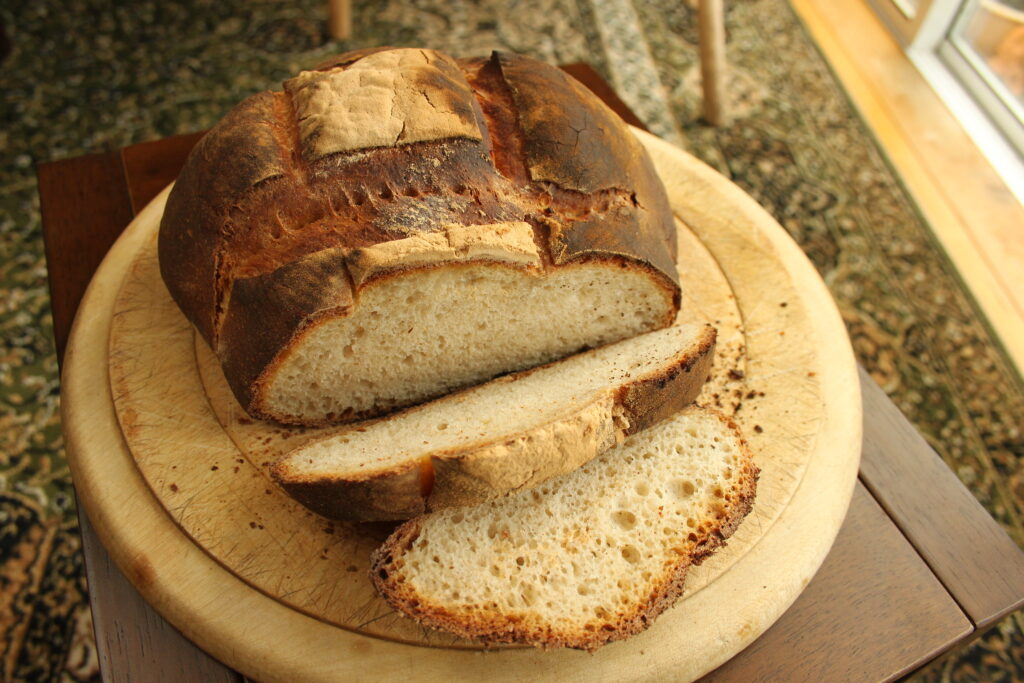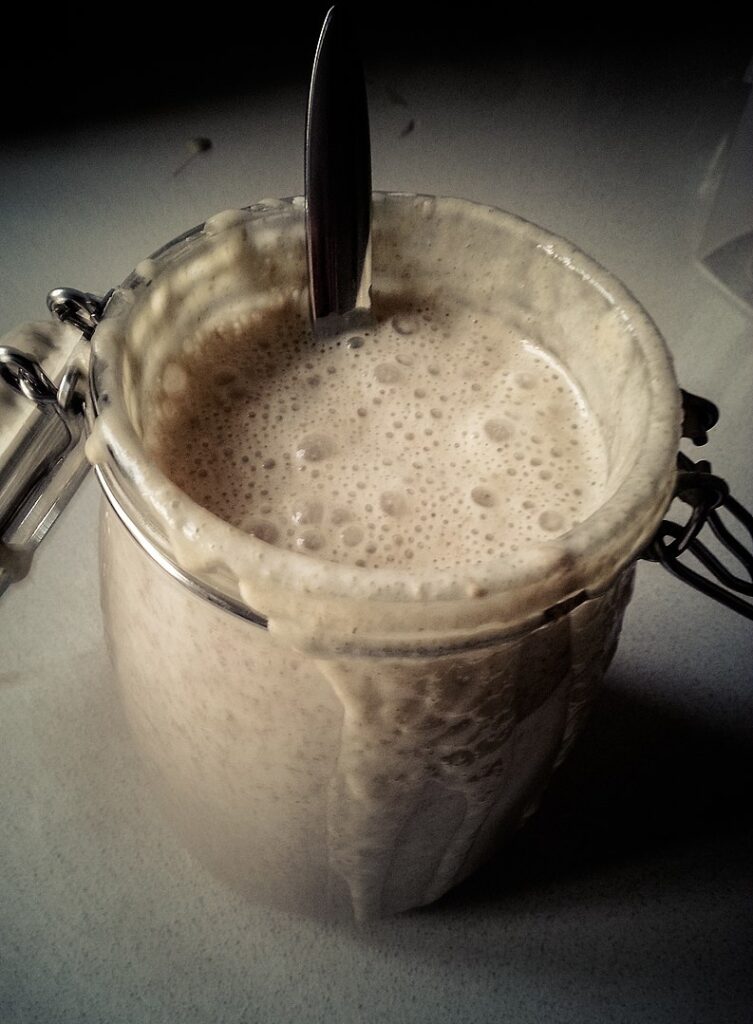The tradition of making sourdough bread using a fermentation of flour and water (known as Sourdough Starter or Sponge), has been around nearly as long as humans have been baking things. One of the oldest sourdough breads from an archeological excavation in Switzerland was dated to 3700 BC, but likely originates thousands of years earlier.
Sourdough was the normal method of leavening bread in Europe during the Middle Ages and was brought to the Americas by settlers. Many people now associate Sourdough with the American Frontier and the western Gold Rushes.

Sourdough loaf. Photo by muffinn on Flickr Creative Commons
Sourdough loaf by Mike Finn is licensed under CC BY 2.0
With the world experiencing the Great Pause for the COVID Pandemic, commodities like dried yeast can be difficult to find. This may be a great time to get your hands into some sourdough.
And it turns out that sourdough starter is pretty hearty, so once you get a batch going, you can take it with you when the roads open back up again and enjoy fresh sourdough pancakes and bread anywhere you travel.
The secret to a good starter is to cultivate the mix of wild yeast and beneficial bacteria naturally found in the flour so that they thrive, giving off carbon dioxide bubbles that turn a flat, dense lump of glue into delightfully light and fluffy bread. As Marcus Woo calls it “if the loaf is the body, the starter is the soul.” Once these microorganisms are established, a good starter can “live” and be used for decades with a little care.
Sourdough bread tends to have a longer shelf-life than traditional yeast bread thanks to the acids produced by the microbes that prevent spoilage. There is also some medical research that indicates the fermentation process of sourdough can help the grains be more digestible for some people with gluten sensitivities. (Keep in mind, however, that some store-bought sourdough breads are “flavored” and not actually created by a sourdough process, so may not have the same qualities.)
There are two methods to getting a good sourdough starter: 1) get some from a friend (or order online), or 2) start your own.

Active, happy sourdough starter (Photo by Janus Sandsgaard)
To start your own, you will need a very clean 1-quart glass mason jar (or similar), wooden or plastic spoon (sourdough acids and metal don’t combine well), flour (all-purpose, bread, whole wheat, rye, etc.), filtered water (microorganisms don’t like chlorinated water), and a measuring cup.
Day 1
Mix ½ cup flour with ¼ cup room-temperature water in the mason jar. It should form a thick paste. It’s ok if it is lumpy. Place a lid loosely on the jar (don’t tighten it—the off-gassing will create pressure) and let it sit at room temperature (~70F) for 24 hours.
Day 2
Check your mix after 24 hours. You may not notice any activity, or you might see some little bubbles forming. If you don’t see bubbles, let the mixture rest another 24 hours (sometimes it takes a little while for things to get going.) If there are bubbles (or after 48 hours), remove half of the mixture and add in another ½ cup flour and ¼ cup water. Mix well, cover loosely and let sit.
With the half you removed (called the “discard”), you can either start another colony by feeding it as you did the first half, or you can use it in a Sourdough Discard Recipe to make something like crackers, pancakes, banana bread, or pop-overs. There are a ton of ideas online.
Day 3
You should see some bubbling and maybe notice a volume change or maybe some warmth and whiffs of that good sourdough scent (it should smell sweet and tangy, not unpleasant or “bad”). Now you will begin feeding the starter twice a day, as evenly spaced as you can.
Each time you feed the starter, you start by removing half into another container, then adding in ½ cup flour and ¼ cup water, stir and cover. It is also fun to try using different flour typed for varied flavors (maybe experiment with one of the discard groups).
Day 4 and 5
Feed twice a day, discarding half, adding in ½ cup flour and ¼ cup water each time. The starter should start looking visibly active, bubbling, rising (close to doubling in size) each feeding. Use the discarded portions for baking or new colonies.
Day 6
Your starter should double in volume within 6 hours of feeding. Give it one last feeding and let it sit for 8 hours. Test the starter with a Float Test. Take a teaspoon of the starter and put it in a glass of water. If it floats, it is ready to make bread! (If it doesn’t pass the float test, just keep feeding it twice a day for a few more days until it is consistently bubbling, rising, and doubling—and passes the float test.)
Once it passes the float test, place the starter in a clean jar for long-term storage. You can store it in the refrigerator and feed it once a week using the same method (warm it to room temp first), discarding any liquid that accumulates. You can take it with you on the road as well for fresh sourdough anywhere you roam!
NOTE: If at any point the starter starts to discolor, mold, or smells “bad”, there may be other bacteria introduced (i.e. from a not-so-clean jar) and you will need to throw it out and start over.

Okay…. maybe I missed a point or I’m an idiot…. either way I don’t understand why you split in half and “discard” one half of the product. Why not just feed the whole pile of dough? What does splitting do?
I think it’s a sacrifice to the yeast gods
Oh yes, you must be right! 😀
I’ve made it for a year, and now have to figure out how to bake it in a small travel trailer oven!
It’s to reduce the amount of flour and water to feed the starter. If you didn’t discard any (make something with it!) you soon would be adding cups of flour and water to an ever increasing volume of starter.
If you don’t discard you will quickly run out of room in the jar.
The less you have after the discard allows the fresh feed to react much better. You get more bubbly quicker…
It’s because the author wants to add a modest amount of flour each day, while maintaining a certain ratio of fresh food to semi digested active base (this includes digestive waste, which will harm the microbes). If you don’t split the active portion but adhere to the ratio, your batch will build up to about 250 cups of flour in the jar (crock… bathtub… ohmygod…) by the end of the first week.
That a good question, did not see any answers.
Why spilt the dough each time. Can the new flour just be added to mixture ?
I started making Sourdough several years ago because mine tasted better.
Have never tried baking it in the 5 wheel. I just take my starter so it says well fed.
The reason you split the barm/sponge is simple. The larger the barm, the faster it will eat what you add. And, the fuller the container, the more gas production. And, the more you need to feed the beast.
If your barm looks a little dodgy, empty all but one inch. Then add 2 inches of filtered water. Shake mixture, then pour out all but one inch. Do it again. Then feed the barm. This washes out the dead cells, alcohol and leaves enough wild yeast to restart the process. I buy my starter yeast from SourDo International. Been using sour dough for two decades. I use a flip top jar and clamp it down. Pressure does build up so always take time to release it carefully. This keeps out unwanted yeast from the surrounding air that can influence the flavors of my starter yeast.
I love SF sourdough bread. I now live in Kansas. Local sourdough bread does not even taste close to the SF stuff. The reason is that the starter gets microbes from the local atmosphere. SF gets it from the ocean air. If you brought starter from SF, within a short period of time it would ingest the local microbes and would no longer taste like SF sourdough. We have a local company that ships in their starter or dough, not sure which. Their’s tastes like SF sourdough bread. Don’t try to make local starter from scratch, it will have a local flavor. Import or use a kit.
Please send your recipe as I have tried King Arthur 2 times and have made perfect bricks.
My starter is working perfectly.
Need some help
Don
Now that my starter is established, I keep it in the fridge & take a small portion out in the evening & feed it for use the next day. (I feed this portion 1starter : 3 each water & flour by weight). The RV oven pilot light is the perfect temperature for the starter overnight, & then for the bread I make.
I feed my small fridge batch occasionally (vs every week & discarding). This has worked for me for the past 5 months.